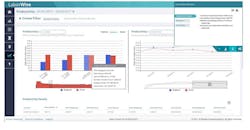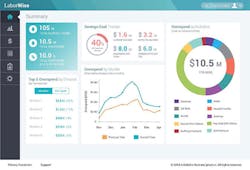If even a tiny fraction of a manufacturer's compressed air escapes unused or raw material discarded to the garbage, you'd want to take action, installing smart sensors to collect data and root out the problem. These tools often offer the type of ROI that makes you feel like a genius when you see the next utility bill or invoice. It also makes you wonder why you didn’t implement the change sooner.
Now imagine you could make simple changes to patch leaks in your factory's largest expenditure: payroll. Labor accounts for as much as 60% of overall operating expenses in Fortune 500 company, says Deloitte, and 0.5 to 2% is due to poor or outdated accounting and scheduling practice for hourly employees. For large companies, that amounts to an overspend on average of $30 million. Instead of just telling plants and factories they are losing money unnecessarily, the firm has created a workforce analytics tool called LaborWise to help recoup it.
At the extreme end, LaborWise found $17 to 25 million in labor costs that could be saved. And most importantly, it's cutting labor costs without eliminating people.
"It's not focused on reducing headcount to drive cost, it's about looking at your current employee base and saying, 'Are we overpaying for the effort that we are getting out of that workforce?'" says Michael Gretczko, Deloitte national service line leader.
LaborWise crawls through your existing enterprise workforce management platform and time and attendance systems, gathering data on labor metrics ranging from missed punches to overtime, and the latest version connects all that to sales and other operational metrics. Deloitte than does what it does best: unraveling exactly where a business's HR practices are inefficient and can be optimized.
"We identify these things that you'd think would be very apparent to client, and yet they are so heads down doing their daily operation and keeping the business going, they miss what's right in front of them," says Jenine Bogrand, LaborWise workforce management leader.
Take a handful of employees forgetting to punch in every day.
"Supervisors have to get the security log, figure out the swipe time, and fix it to get worker paid," she explains. "Supervisor productivity comes down. It was costing time and energy to do this research."
If you've had to do this, you probably think it's a pain to do and obnoxious on the part of absent-minded workers, but it's also a huge time suck considering all the other vital tasks you should be spending your time doing, like perusing the latest issue of New Equipment Digest to improve production.
One consumer product manufacturer that operates nine plants had 275,000 missed punches in a year. That's something LaborWise easily identified and attached a dollar amount, Bogrand says.
"This can be as simple as 'highly encouraging' the supervisors/managers to communicate to their employees that it is in their best interest to punch in/out as it will assist in providing them a ‘perfect' paycheck," Bogrand says. "If there is still an issue then they would consider it a performance issue and document/counsel accordingly."
Unfortunately, Deloitte does not recommend using a cattle prod on non-compliant workers, so instituting a more formal policy would be the next measure.
LaborWise can also help a company restructure how vacation time and sick days are managed, ensuring the right people can fill in and production doesn’t take a hit when someone takes off. No one wants a situation like American Airlines dealt with last Christmas.
Another example is overtime. In one case, because only senior workers were trained on certain tasks, they were accruing all the extra hours. Because they are the highest paid, that time and a half really added up. Taking the time to train junior workers reduces overtime spend, and provides a more fair environment for your workforce.
"They knew they had overtime issues; they just didn't know why," Bogrand says.
While no one is losing their job, this scenario does create a redistribution of wealth. The OT the senior employees were getting would now go to someone else. How do you handle that?
"It's a hard conversation," says Bogrand, not shying away from the question. "You still have to be equitable to the entire group, and look out for your bottom line. Someone is going to be unhappy with that conversation."
She does say where LaborWise works best, in companies with more than 3,000 hourly employees "with complex rules," oftentimes overtime is regulated by union contracts. The more data that management has, the more prepared and knowledgeable they can be negotiating a proper and balanced agreement.
Deployment can take two to three months, and requires only "small asks" of the client. It does get a bit more difficult if a company manually enters data on spreadsheets and not a time and attendance system.
Even with companies of 3,000 or more, Bogrand says this does still happen: "We're still seeing some that are back in the dark ages."
Whether it's an outdated and up-to-date system being used, Deloitte will dive in and surface with savings. This is all done with minimal action or risk on client's part. At the end of the assessment, Deloitte may provide around 10 executable actions and how much it would save.
"Deployment is extremely inexpensive," Bogrand says. "We can also invest with client and what you pay us is a percentage of what you're saving. That works out really well. It feels more like a partnership then a project."
As with improving any plant inefficiency, the "extra" money you know have can go to where it should: investing in the areas to make your business more competitive.
That's what Bogrand saw with one company that implemented LaborWise.
"They took savings and we're able to roll that into a project they were trying to get funded."








